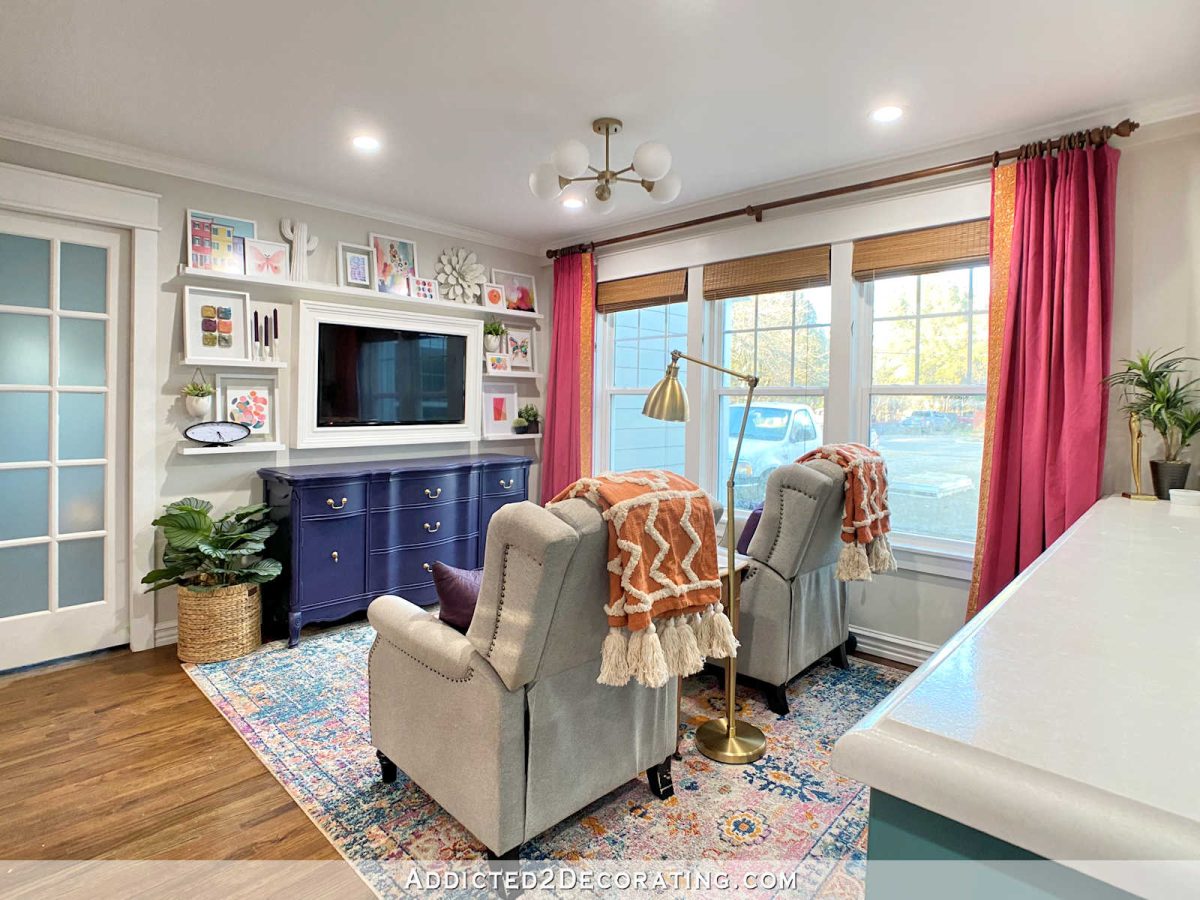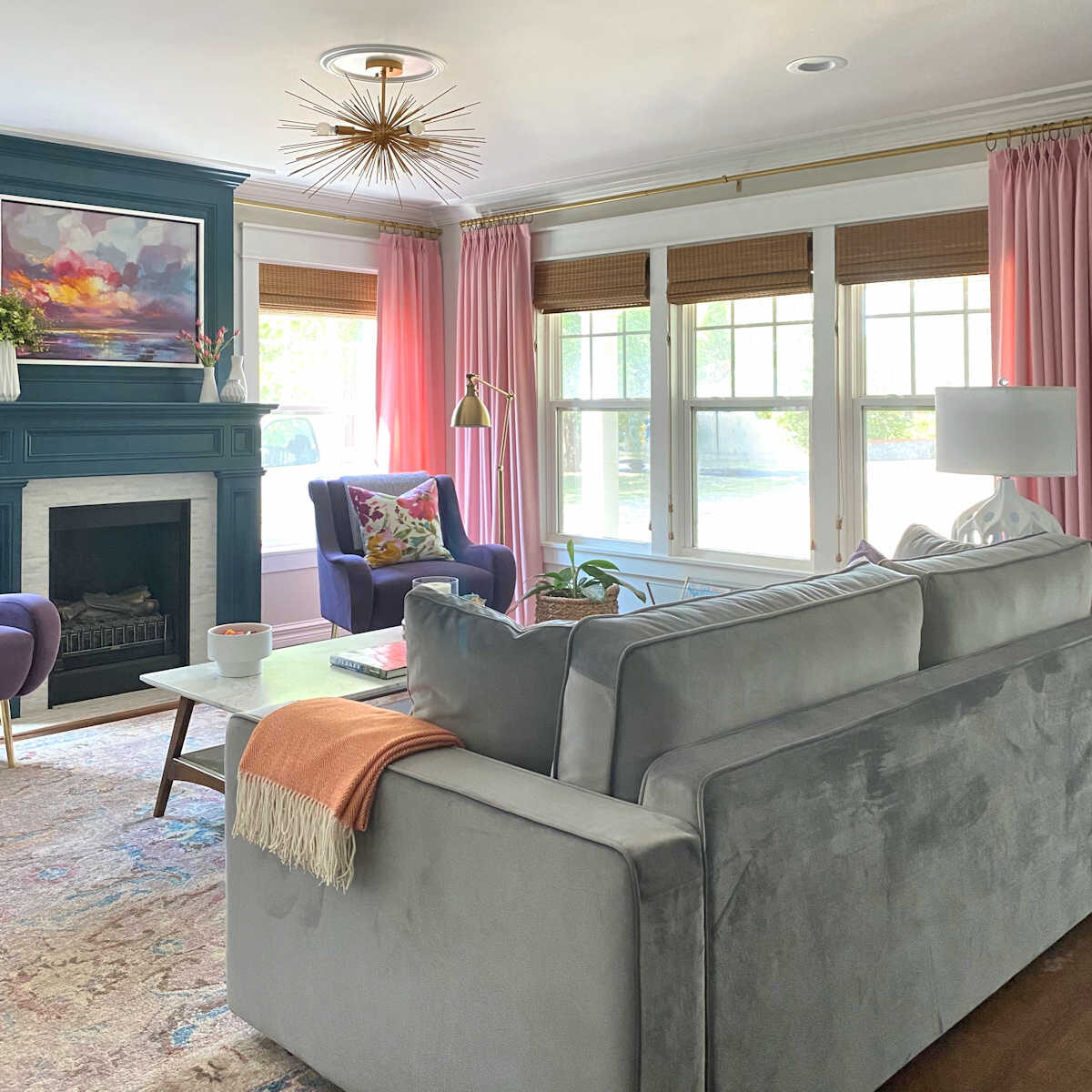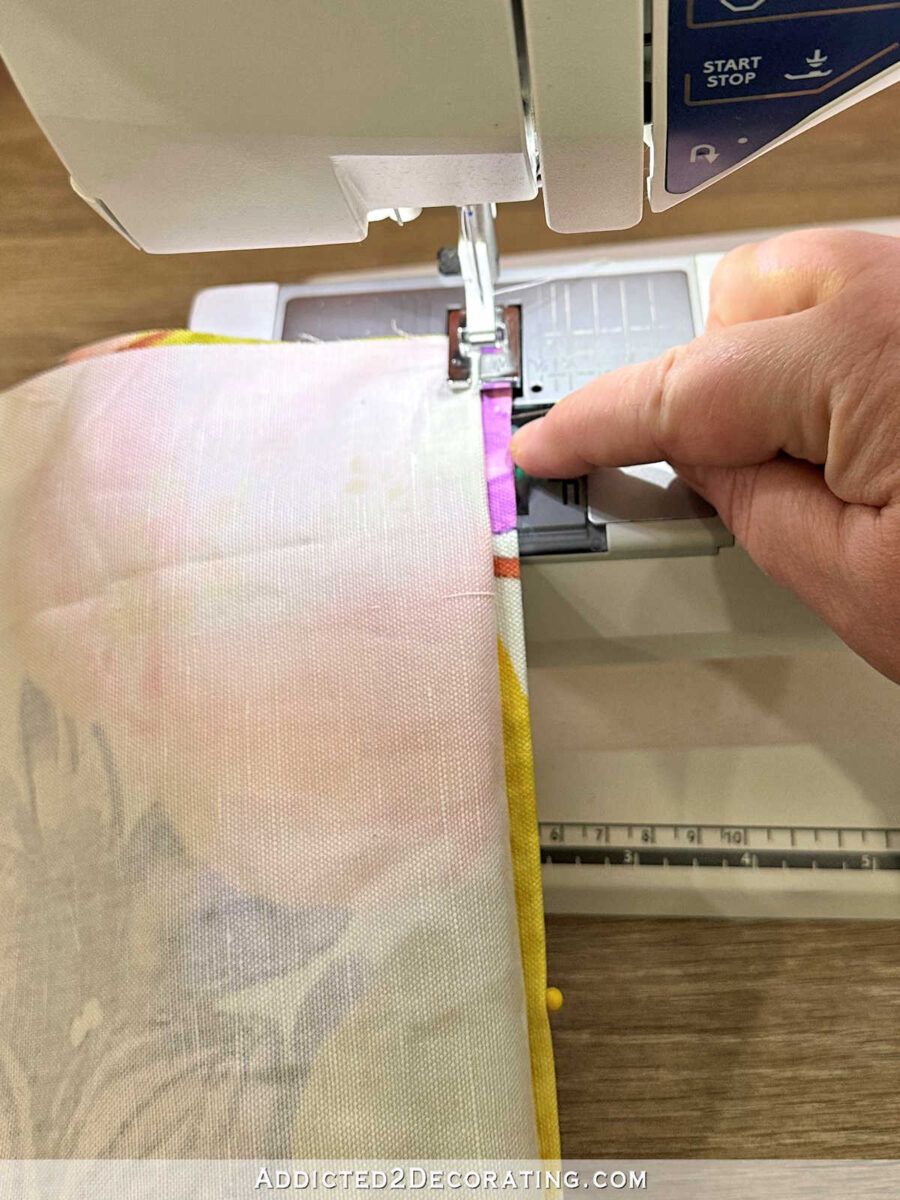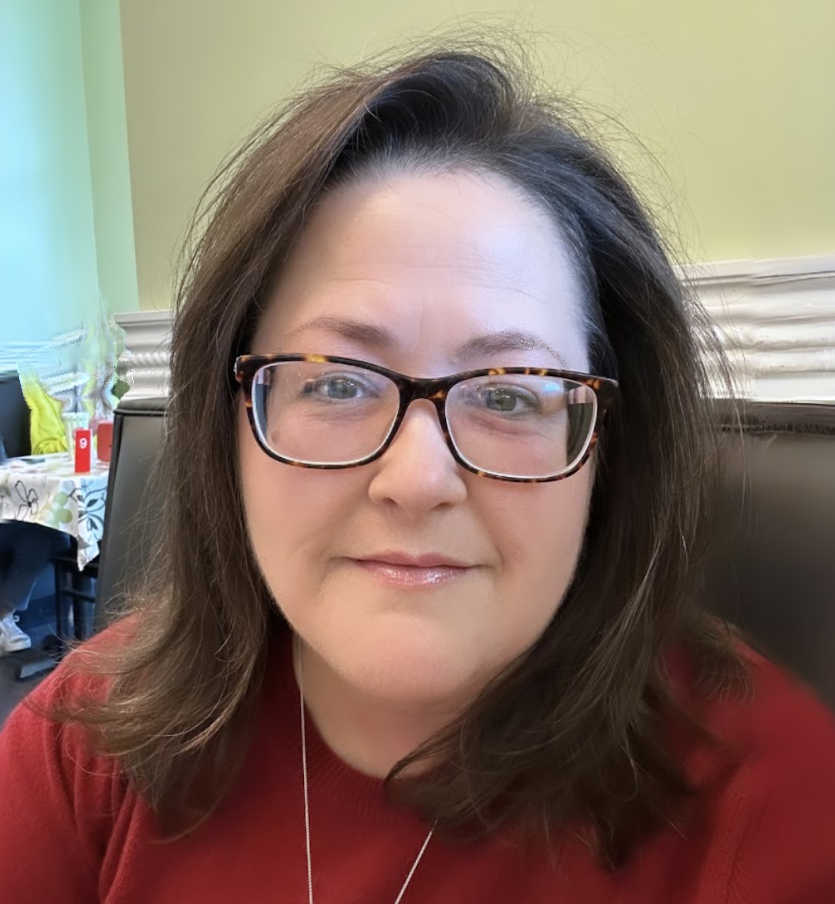
Final week, I posted maybe the longest and most thorough tutorial I’ve ever posted on my weblog. That two-part tutorial on how you can make lined, pinch-pleated curtains, had a complete of 107 photographs in two posts. In the event you missed it, you possibly can see these posts right here:
I did get some questions that I needed to reply, plus I wish to add slightly extra data that I hope can be useful.
A Clarification
First, I wish to make clear that the tutorial is just for making single-width (clearly), stationary, ornamental curtain panels. I just about by no means use my curtain panels to really cowl a window for privateness or to dam out gentle. That’s why my home windows are nearly all the time dressed with each curtain panels (so as to add softness, shade, sample, and so on.) and woven shades (for privateness and to really block out gentle).
For instance, the curtains in our sitting room aren’t huge sufficient to cowl all three home windows. Their solely job is to hold there and look fairly by including shade, texture, and visible peak to that wall. If we wish privateness or gentle management in there, I shut the shades.

If you wish to make operable pinch-pleated curtains, that’s a complete completely different factor. First, you must determine what number of widths of cloth to make use of for every panel (the entire width of the curtains is usually 2.5 to three instances the width of the window(s)), after which you must do some precise, actual math to determine what number of pleats to make use of, and the way a lot cloth can be utilized by the pleats with a purpose to have sufficient width left to really cowl the window when the curtains are closed. I imply, it’s not a venture to be tackled by the faint of coronary heart. 😀
Now I’ll say that even if you happen to’re panels can be stationary and ornamental, it’s a lot better to stitch a double-width panel in case your window (or span of home windows) is actually huge. In the event you want that on your window, I have this old tutorial for sewing double-width lined drapery panels.
In an ideal world, the curtains for our sitting room home windows (pictured above) ought to have been double-width panels. However I actually needed to make use of that cloth, which I had bought for one more venture, and I solely had sufficient to do single-width panels. It’s fantastic, but it surely makes it very apparent that they’re solely ornamental. That’s only a matter of private choice. Some individuals don’t thoughts that. But when I have been to do these over once more, and truly buy cloth particularly for these home windows, I’d be sure that I used two widths of cloth for both sides.
Why I Want Blackout Lining
I had somebody ask me why I take advantage of blackout lining when there’s no direct daylight coming in by the again doorways of my studio. These doorways are coated by the carport, so direct daylight by no means reaches these doorways. After all, you should use no matter form of lining you favor in your draperies. I bought within the behavior of utilizing blackout lining on my draperies years in the past for 2 completely different causes.
First, I really like the burden that it provides to the curtain panels. As a result of blackout lining is thicker and heavier than each different form of lining (not less than those I’m conversant in), it provides a weightiness to the panels that I feel may be very good. The substantial weight and really feel of a pane lined with blackout lining makes them really feel extra luxurious to me. Plus, I’ve by no means even as soon as had to make use of material weights on any panels I’ve made utilizing blackout lining.
However the primary cause blackout lining is my go-to lining is as a result of I don’t like even the slightest little bit of daylight coming by my material panels, particularly once I’ve used a colourful patterned cloth. Any gentle that comes by the panels can doubtlessly distort the colours, and that bothers me tremendously.
I discover this in our lounge the place I’ve the pink, unlined curtains. As a result of I broke my very own rule in that room and used a stretchy attire cloth (I couldn’t assist myself as a result of the colour and weight of the material was excellent), I wasn’t in a position to make the material work with lining. So that they’re unlined, and anytime gentle shines by them (and it doesn’t must be direct daylight), they seem like a distinct shade of pink.
You possibly can see that on this picture beneath. These two curtain panes within the nook seem like two completely different colours, and it’s not simply the world getting direct daylight on the panel on the left that appears completely different. There’s additionally a strip of the far proper panel that may be a completely different shade regardless that that by no means will get direct daylight because it’s beneath the entrance porch.

It’s a private choice, however I don’t like that. Some day sooner or later, I plan to search out some precise decorator cloth on this pink (even when I’ve to have it printed myself at Spoonflower) in order that I could make new pink curtains for this room, and I can truly line them in order that they’re all the time a constant shade regardless of how sunny it’s outdoors.
I discovered this lesson the laborious manner when Matt and I purchased our first home in Albany, Oregon, quickly after we bought married. It was my first alternative to embellish a complete home all on my own, and I discovered a fairly (to me on the time) plaid cloth that had all types of colours in it — crimson, yellow, inexperienced, blue. I cherished that cloth, and made some unlined curtains for one of many bedrooms. And as quickly as I hung these curtains, the sunshine coming by that cloth made them look orange. The entire element of the small plaid design was misplaced, they usually simply appeared orange. I used to be so upset, however I discovered a helpful lesson that day. So once I later discovered about blackout lining, I knew that will be my go-to lining for that very cause.
A Clarification On Blind Hems
As I used to be writing the tutorial, I knew that if one half was going to be complicated, it will be the half in regards to the blind hem sew. And certain sufficient, I bought a couple of questions on that step.
In order I made the second panel (which I completed final night time!), I took some further photos of this step for additional clarification. I’ll add these to the unique submit, however for individuals who have been confused, that is the element I used to be lacking in Half 1 of the tutorial exhibiting how you can do the blind hem.
After turning up, pinning, and ironing within the double four-inch hem within the backside of the face cloth, it seems like this…

In an effort to sew the blind hem sew, you merely flip the double folded cloth again beneath the panel like this…

In order that when it’s mendacity flat, all you see is about 1/4-inch of the highest fold of the hem protruding as a result of the remainder is folded again beneath the panel.

After which you possibly can take that to your machine and stitch utilizing the bind hem sew setting. It’ll do about 4 stitches on that high fold of the hem, after which about as soon as each 5 stitches, it’ll attain over to the left and put a single sew by the entire layers, after which it’ll return to the precise 4 one other 4 or 5 stitches.

Anyway, I hope that clarifies that step. I’ll get these photographs added to Half 1 of the tutorial later at this time in order that this step can be simpler to grasp.
My Recommendations For Material Choice
In the event you’ve by no means made lined draperies earlier than, I strongly recommend that you simply select your cloth very fastidiously. In the event you attempt to bounce proper into making lined draperies utilizing a difficult cloth, you’ll in all probability wish to hand over, and also you’ll be cursing me for convincing you that making lined curtains actually isn’t all that tough. 😀
My suggestion is to make use of a material that can very simply lie flat in your work floor, received’t crawl each time you contact it or when it’s sewn, has a little bit of thickness to it (however not an excessive amount of!!), and may simply be “pressed” together with your fingers. This could be 100% cotton materials, cotton/linen blends, and the like. The material I used for the panels in my studio is from Spoonflower, and it’s their linen cotton canvas. I feel it is a excellent cloth for a newbie. And all the time, ALWAYS use an precise decorator cloth.
So what materials do you have to keep away from? Keep away from any materials which might be skinny and crawly, like skinny polyesters, rayon, silk, skinny linen, and so on. Any cloth that has a stretch to it must be rued out utterly. Additionally keep away from something too thick, like velvet and most materials meant for upholstery. Belief me, you do not need your first time making pleats to be on a material that’s too thick. Additionally, regardless of how tempting it’s, DO NOT use an attire cloth to make curtains. Simply don’t. (Do as I say and never as I do. 😀 ) I’ll say it once more. At all times be sure to’re utilizing an precise decorator cloth on your curtains. And don’t wash the material first. You’ll spoil it.
I feel that’s it for now, but when I consider every other useful data, I’ll add it to this submit. And naturally, if in case you have any extra questions, simply let me know!
Addicted 2 Adorning is the place I share my DIY and adorning journey as I rework and embellish the 1948 fixer higher that my husband, Matt, and I purchased in 2013. Matt has M.S. and is unable to do bodily work, so I do nearly all of the work on the home on my own. You can learn more about me here.








